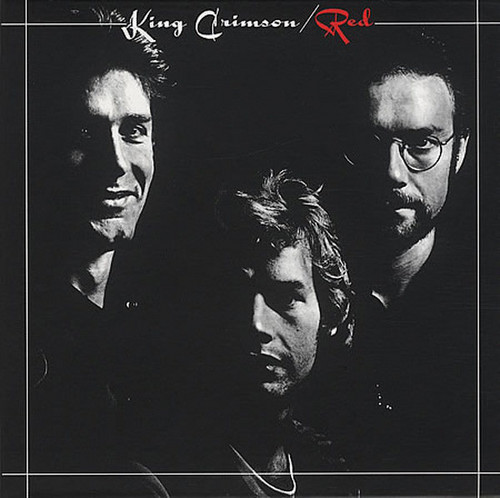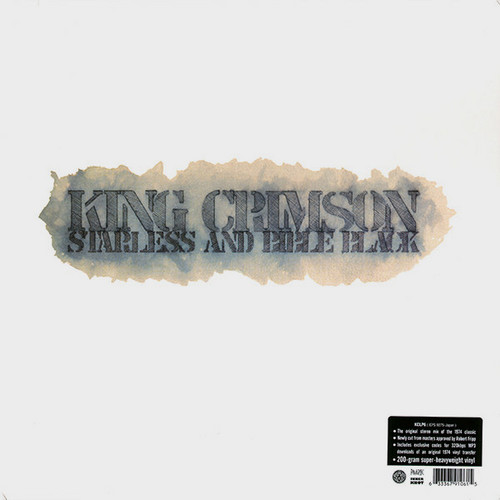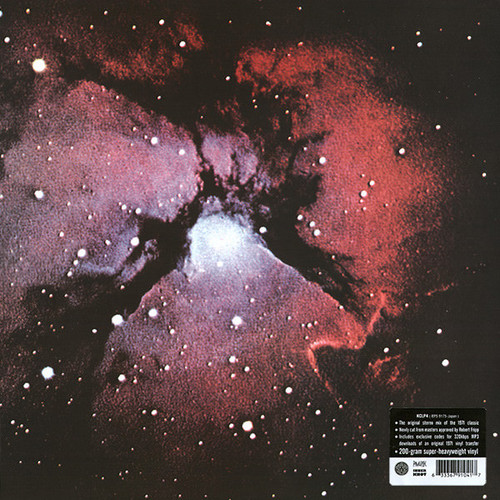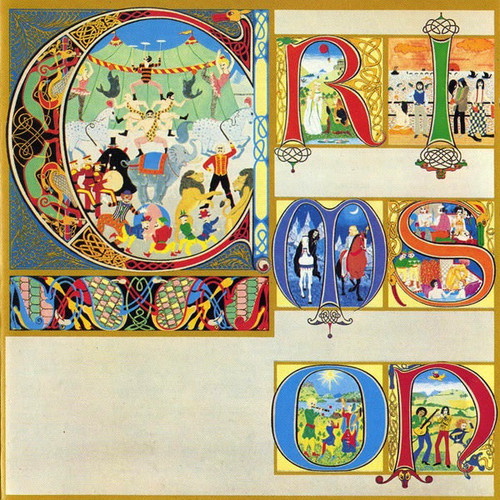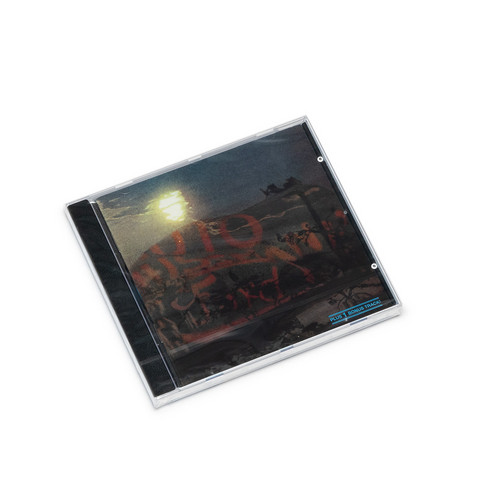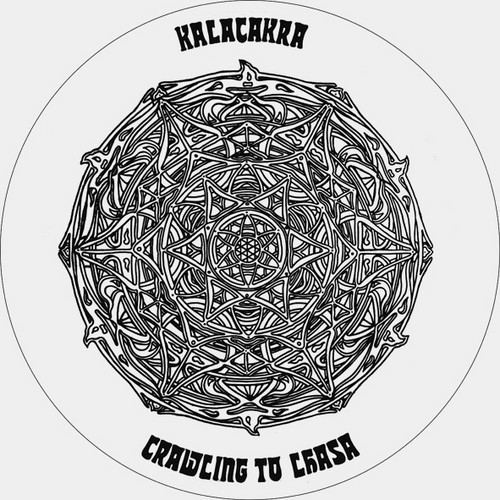Psych /
Red
Red is the fourth in a series of audiophile King Crimson vinyl reissues. Newly cut from masters approved by Robert Fripp, this super-heavyweight 200gm vinyl re-issue is housed in a reprint of the original sleeve. One of the most powerful and influential albums in the band's remarkable career. King Crimson fell apart once more, seemingly for the last time, as David Cross walked away during the making of this album. It became Robert Fripp's last thoughts on this version of the band, a bit noiser o…
Starless and Bible Black
"Starless and Bible Black is the eighth in a series of audiophile King Crimson vinyl reissues and completes the availability of the band's studio output from 1969/74 on 200g vinyl editions. Newly cut from masters approved by Robert Fripp, this super-heavyweight vinyl re-issue is housed in a reprint of the original gatefold sleeve. Starless and Bible Black is even more powerful and daring than its predecessor, Larks' Tongues in Aspic, with jarring tempo shifts, explosive guitar riffs, and soaring…
Larks' Tongues In Aspic
Larks' Tongues In Aspic is the fifth in a series of audiophile King Crimson vinyl reissues. Newly cut from masters approved by Robert Fripp, this super-heavyweight 200gm vinyl re-issue is housed in a reprint of the original sleeve. With its raw tone, inspired improvisations and hard hitting odd-metered rhythms, the album marked a radical departure for this most forward thinking of groups and was the first to include Bill Bruford and John Wetton as band members. King Crimson reborn yet again -- t…
Islands
Islands is the sixth in a series of audiophile King Crimson vinyl reissues. The album's return to the 12" vinyl format is newly cut from masters approved by Robert Fripp. Manufactured on 200g super-heavyweight vinyl, housed in a reprint of the original sleeve with lyrics insert. The album is a hodge podge of ideas and there is no flow or continuity. Each track could exist separately. This is one of the Crims least beloved lineups even tho they were capable of more free-jazz improv than any previ…
Lizard
Released in December 1970, King Crimson's third studio album, Lizard, is often viewed as an outlier in the pioneering British prog outfit's nearly half-century discography. It's not easily grouped with 1969's stunning In the Court of the Crimson King debut and 1970 follow-up In the Wake of Poseidon, and along with 1971's Islands it's considered a transitional release on the band's path toward the relative stability of the Larks' Tongues in Aspic (1973), Starless and Bible Black (1974), and Red (…
In The Wake Of Poseidon
**classic prog-rock masterpiece gets the reissue on 200 gram vinyl** King Crimson opened 1970 scarcely in existence as a band, having lost two key members (Ian McDonald and Michael Giles), with a third (Greg Lake) about to leave. Their second album -- largely composed of Robert Fripp's songwriting and material salvaged from their stage repertory ("Pictures of a City" and "The Devil's Triangle") -- is actually better produced and better sounding than their first. Surprisingly, Fripp's guitar is n…
In the Court of the Crimson King
**Recent repress, classic prog-rock masterpiece gets the reissue on 200 gram vinyl** The group's definitive album, and one of the most daring debut albums ever recorded by anybody. At the time, it blew all of the progressive/psychedelic competition (the Moody Blues, the Nice, etc.) out of the running, although it was almost too good for the band's own good -- it took King Crimson nearly four years to come up with a record as strong or concise. Ian McDonald's Mellotron is the dominant instrument,…
Latinoamérica
Sole release by this Colombian band that surfaces briefly after the Speakers, Young Beats, Ampex and Time Machine era comes to an end. The band boasts an Italian jazz-rock drummer Roberto Fiorilli and legendary Genesis Bassist Humberto Monroy. The record consists of one theme divided into two long experimental progressive ventures (Viaje I and Viaje II) of fierce, fluid and free collective improvisation with spacey feels and a rich texture of Hammond organ, guitar, bass, tenor sax, percussion an…
Nyl
Nyl 1976 sole release is curiously still very much under the radar despite it being one of the most intriguing French psychedelic/prog albums from the 70’s. The music is highly creative and energetic with a definite space-rock feel in the style of Hawkwind, but also a clear krautrock edge reminiscent of Amon Dull II and Agitation free. Michel Peteau’s guitar is the driving force around which all other elements create a whirlwind of sonic psychedelic infusion veering between loud psychedelia and …
Absolutely Free
2017 release. In celebration of the 50th anniversary of Frank Zappa and the Mothers of Invention’s classic, groundbreaking 1967 album Absolutely Free, the Zappa Family Trust has released an expanded, vinyl-exclusive edition of the album in double-LP pressed on shiny black 180gram vinyl, mastered by Bernie Grundman, and cut directly from the original analog master tapes.While the first disc offers the original album in all its glory, the second disc in the set features twenty minutes of rare and …
Sukram Gurk
Siloah were re-formed by Thom Argauer in late 1971 after their Munich hippie community had split following the release of the band’s first record. Although "Sukram Gurk" was recorded under the same elementary conditions as its predecessor and had a similar psychedelic touch, it fails a bit to achieve the sort of charisma evident in the first record. Thom now played the keyboards instead of the guitar. Re-issue from the master …
Electrip
"Psychedelic music from Wisbaden, with some jazz elements. Recorded in 1969. After the Germanofon bootleg, here is the legal re-release with a 32 page color booklet and their two 7" tracks as a bonus." First legit CD reissue of the legendary first Xhol album, first issued on Hansa in 1969. This was their first of 3 albums, Hau-Ruk and Motherfuckers GmbH & Co. would follow on the OHR label in '71/'72, concluding one of the strangest chapters in the Krautrock scene of this period. Electrip has…
Altena 1969
"Still with their black singer James Rhodes. A concert from spring 1970 in the lovely town of Altena. The cover shows sax player Tim Belbe in Charles Manson style. Good quality."
Supernova
2009 release. "With several connections to the early Kraftwerk history and formed in the Rhineland area in 1971, Ibliss was a quintet formed by percussionist Basil Hammoudi (from Organisation, the band before Kraftwerk), drummer Andreas Hohmann (also from Kraftwerk), brothers Wolfgang and Norbert Büllmeyer (bass and guitar respectively) and Rainer Büchel on sax and flute. With the help of Conny Plank, they recorded their one and only LP at Hamburg's Windrose-Studios: four long instrumental track…
Bacchanal
Gabor Szabo was at his creative peak at the end of the 60s, when he recorded his masterpiece “Bacchanal”. Szabo’s 60s quintet, featuring guitarist Jimmy Stewart, is on top form here with another of his unique collections of both jazz and pop hits. His restrained use of feedback at just the right moments shows Szabo was willing to open up to new sounds yet he keeps a tight grip on his signature sound throughout these eight cuts.
Crawling To Lhasa
**Picture Disc edition with an insert of 8 pages and is also limited to 1000 hand-numbered copies.** Against its remarkable, sprawling, and lasting influence, it is hard to image the 1960’s and 70’s German sonic counterculture as it was - a truly underground music, almost entirely unknown beyond the borders of the country from which it sprang. Across the ensuing decades, this scene - among the most ambitious, rebellious, and experimental of its day, has offered an unparalleled wealth of inspirat…
Siloah
Siloah were a German progressive psych / folk band in the vein of Kalacakra, Langsyne and others "curiosities". Siloah are one of the best kept secrets of the krautrock production. Siloah had a hard core including Thom Argauer, Manuela von Perfall, Heinrich 'Tiny' Stricker and Wolfgang Görner, plus a host of guests coming and going, everybody was free to join and play at any time, guest members often joining from the Baumstassen commune around which the band was living before they eventually mov…
Bury My Heart At Wounded Knee
Originally based in Stuttgart Conny Veit’s Gila had already recorded a more rocking psychedelic first album with a different line-up when Veit was invited to Munich to record “Hosianna Mantra” for Florian Fricke’s Popol Vuh. Hanging around frequently at Amon Düül’s commune in Kronwinkel he met Daniel Fichelscher who played and recorded with Amon Düül II at that time. Veit was impressed with Fichelscher’s drumming and decided to revive Gila with Fichelscher on drums, Veit playing guitar and his t…
Auf Der Bahn Zum Uranus
With deluxe four-page insert. Limited to 1000 handnumbered Picture Discs. Top sound quality. This record is frequently, deservedly listed on various "best of krautrock" lists around the Internet. That misused terms is made to stand in for just about all German progressive and electronic/experimentalist music from roughly 1969-76. Their band name derives from the ancient Greek gods, where Gaia (Latin notation: Gäa) is the goddess of the earth and fertility. The group's only LP, Auf der Bahn…
Alraunes Alptraum
Gäa from the German state of Saarland have become quite known in collectors’ circles thanks to their LP "Auf der Bahn zum Uranus" from 1974. In early 1975 they recorded three tracks for a, however, unfinished second album. They are simply brilliant and show how mature and inventive the band was at that time. The tracks have been rediscovered later and form the heart and major part of the LP, which also contains four minor bonus tracks from the 80s. Although these tracks are no longer progressive…
